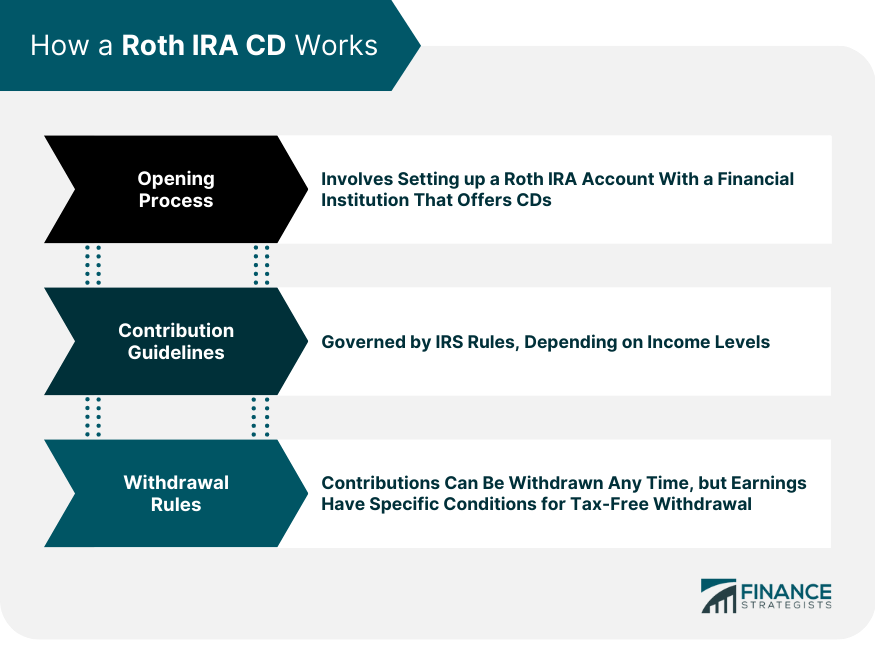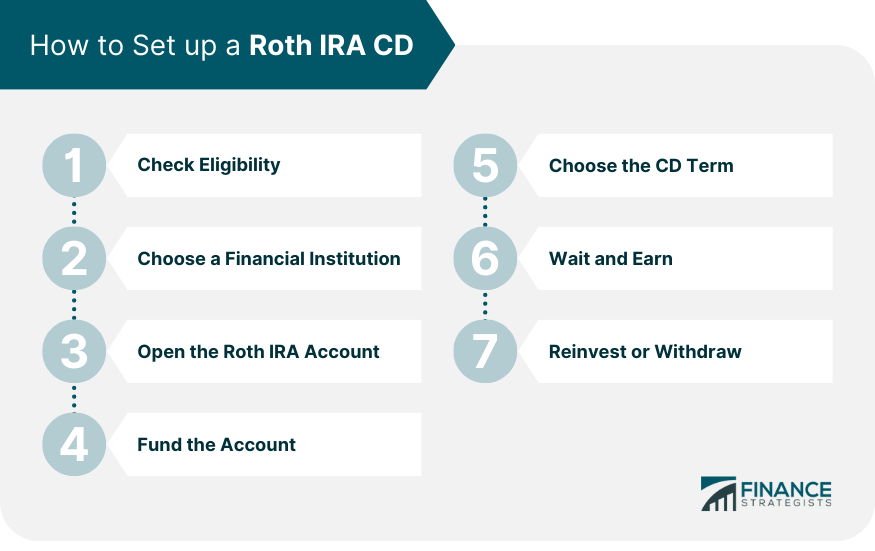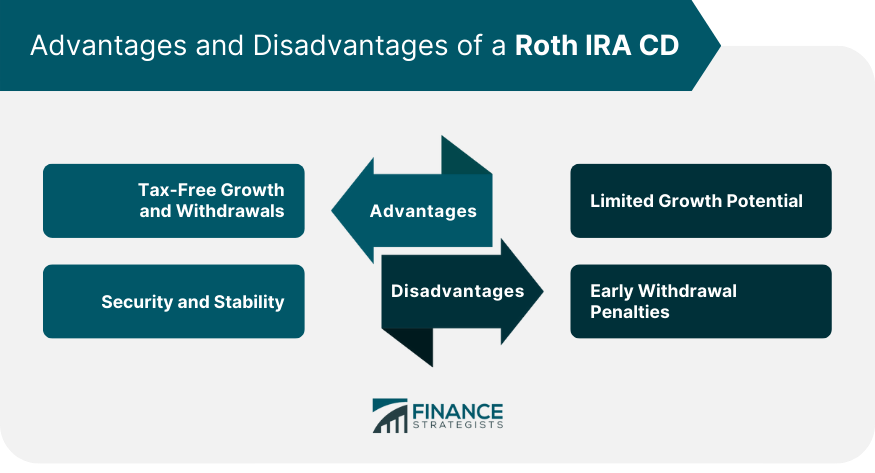A Roth IRA CD is a type of retirement savings account where you deposit after-tax money. It's called a 'CD' because the investment within the Roth IRA is a Certificate of Deposit, a type of time-bound deposit offered by banks with a fixed, generally higher, interest rate than regular savings accounts. The CD in a Roth IRA CD offers a fixed interest rate over a specified term, providing a predictable growth rate for your investment. The primary purpose of a Roth IRA CD is to provide a secure and low-risk investment option for retirement savings. The tax benefits of a Roth IRA and the stable returns of a CD make it a reliable retirement savings vehicle. This tool can bring balance to a diversified portfolio, particularly for those who prefer a conservative approach to investment. Opening a Roth IRA CD involves setting up a Roth IRA account with a financial institution that offers CDs. You specifically select a CD as your investment when setting up the account. The process is usually straightforward, but it's essential to review the terms and conditions associated with the CD before finalizing your investment. The Internal Revenue Service (IRS) sets the contribution limits to a Roth IRA CD, and they change year by year. Eligibility to contribute depends on income levels, with higher income earners being phased out from making contributions. It's essential to be aware of these limits and your eligibility to avoid any complications. You can withdraw contributions from a Roth IRA CD at any time without penalty because contributions are made with after-tax money. But to withdraw earnings tax-free, the account must be at least five years old, and you must be at least 59 and a half. These withdrawal rules are designed to encourage long-term savings and should be considered when planning your retirement investment strategy. Firstly, make sure you're eligible to open a Roth IRA. Your eligibility largely depends on your income. As of 2024, single filers must have a modified adjusted gross income (MAGI) under $161,000 ($165,000 in 2025), and for those who are married and filing jointly, the MAGI must be less than $240,000 ($246,000 in 2025). You can open a Roth IRA CD at most banks or credit unions, as well as through online brokerage firms. When choosing a financial institution, compare the annual percentage yields (APYs), terms, minimum deposit requirements, and early withdrawal penalties. Look for FDIC or NCUA insured institutions for safety. Once you've chosen an institution, you can usually open your account online, though some may require you to visit a branch or call a customer service number. During the application process, you'll need to provide personal information such as your Social Security number, date of birth, contact information, and employment information. After the account is opened, you'll need to deposit money into it. You can do this via a bank transfer, mailing a check, or a rollover from another retirement account. Ensure you don't exceed the annual contribution limit (as of 2024 and 2025, $7,000 or $8,000 if you're age 50 or older). CDs typically come with terms that range from a few months to five years or more. The interest rate is usually higher for longer-term CDs. But remember, withdrawing your money before the term ends could result in a penalty. Choose a term that aligns with your investment timeline and comfort level with risk. Once you've funded your CD, your job is mostly done. Your money will grow at the predetermined rate until the CD term ends. When the term ends, you can withdraw your money, renew the CD, or invest in a different CD or another type of investment within your Roth IRA. Remember, with a Roth IRA, you can withdraw your contributions at any time without penalty, but earnings should generally stay in the account until you reach age 59 1/2 to avoid taxes and penalties. The interest rate on a CD is fixed for the term of the CD, whether that's six months, one year, or five years. The higher the interest rate, the more your money will grow. The certainty of this fixed interest rate can offer peace of mind, as it guarantees a known return on your investment. When comparing different Roth IRA CD offerings, it's crucial to understand that the advertised rate might not be the annual percentage yield (APY). The APY considers compound interest over a year, providing a more accurate reflection of your potential earnings. So, always compare APYs, not just the interest rates, when considering different Roth IRA CDs. One of the biggest advantages of a Roth IRA CD is the tax benefits it offers. Contributions are made with after-tax dollars, allowing the money to grow tax-free within the account. Moreover, qualified withdrawals during retirement are also tax-free. This means that the total growth of your investment is yours to keep. A Roth IRA CD provides a secure and stable investment option. The fixed interest rate guarantees a known return on your investment, regardless of market fluctuations. This characteristic makes a Roth IRA CD an excellent option for investors who prefer low-risk investments or those nearing retirement who want to protect their savings from market volatility. While a Roth IRA CD offers stability, it may not offer high returns. Compared to riskier investments like stocks or mutual funds, the growth potential of a Roth IRA CD is relatively limited. If you're younger and have a higher risk tolerance, you might find more lucrative growth opportunities in other types of investments. Another drawback to consider is the potential for early withdrawal penalties. If you withdraw the funds in the CD before the term ends, you could face penalties. This restriction can make a Roth IRA CD less flexible than other investment options, which could be a disadvantage if you need to access your funds earlier than anticipated. If you're in the process of planning for retirement and want a low-risk, predictable growth investment, a Roth IRA CD could be a good choice. This tool can provide a stable component to a diversified portfolio, potentially reducing overall portfolio risk. Plus, the tax-free withdrawals during retirement can be a significant advantage as you strategize for your financial future. A Roth IRA CD can also be beneficial if you're in a period of life where financial stability and security are paramount. This could be a time when you're saving for a big purchase or when market volatility makes you nervous. The fixed interest rate of a CD provides a predictable return, which can be reassuring in uncertain economic times. When selecting a Roth IRA CD, it's important to consider factors such as the CD's term length, the interest rate, the minimum deposit requirement, and the reputation of the offering institution. Each of these elements can impact the effectiveness of your investment. A longer-term CD may offer a higher interest rate, for instance, but it also requires you to lock your money away for a longer period. Just as you would compare prices when shopping for a car or home, it's critical to shop around for the best Roth IRA CD. Different institutions offer varying interest rates and terms. Utilizing online comparison tools or speaking with financial advisors can help you navigate these options and identify the most advantageous Roth IRA CD for your specific financial goals and circumstances. This can mean the difference between an average return and an excellent return on your investment. A Roth IRA CD combines the tax advantages of a Roth IRA with the security and predictable growth of a Certificate of Deposit. It serves as a low-risk, stable investment tool, particularly attractive to conservative investors or those close to retirement. Despite its benefits, investors should be aware of its limited growth potential compared to riskier assets and the possibility of early withdrawal penalties. Timing, comparison of offerings, and understanding of the terms and conditions can significantly impact the efficiency of this investment tool. Therefore, thorough research and consideration of personal financial circumstances and goals are imperative when opting for a Roth IRA CD. If you're considering adding a Roth IRA CD to your retirement portfolio, consult with a banking professional who can guide you through the process and provide personalized advice.What Is a Roth IRA CD?
How a Roth IRA CD Works
Opening Process
Contribution Guidelines
Withdrawal Rules

How to Set Up a Roth IRA CD
Check Eligibility
Choose a Financial Institution
Open the Roth IRA Account
Fund the Account
Choose the CD Term
Wait and Earn
Reinvest or Withdraw

Role of Interest Rates
Impact on Earnings
Importance of Comparison
Advantages of a Roth IRA CD
Tax-Free Growth and Withdrawals
Security and Stability
Disadvantages of a Roth IRA CD
Limited Growth Potential
Early Withdrawal Penalties

Right Time to Consider a Roth IRA CD
Retirement Planning
Financial Stability and Security
How to Choose the Best Roth IRA CD
Factors to Consider
Importance of Shopping Around
Final Thoughts
Roth IRA CD FAQs
A Roth IRA CD combines the tax advantages of a Roth IRA with the stability of a CD, providing a low-risk option for retirement savings.
A Roth IRA CD works by offering a fixed interest rate for a set term, with contributions made with after-tax dollars and withdrawals in retirement being tax-free.
The main advantages of a Roth IRA CD are tax-free growth and withdrawals, as well as security and stability due to a fixed interest rate.
While secure, a Roth IRA CD has limited growth potential compared to riskier investments and can have penalties for early withdrawals.
Choosing the best Roth IRA CD involves comparing terms and interest rates from different financial institutions and aligning these factors with your financial goals.
True Tamplin is a published author, public speaker, CEO of UpDigital, and founder of Finance Strategists.
True is a Certified Educator in Personal Finance (CEPF®), author of The Handy Financial Ratios Guide, a member of the Society for Advancing Business Editing and Writing, contributes to his financial education site, Finance Strategists, and has spoken to various financial communities such as the CFA Institute, as well as university students like his Alma mater, Biola University, where he received a bachelor of science in business and data analytics.
To learn more about True, visit his personal website or view his author profiles on Amazon, Nasdaq and Forbes.











